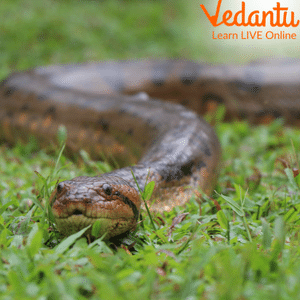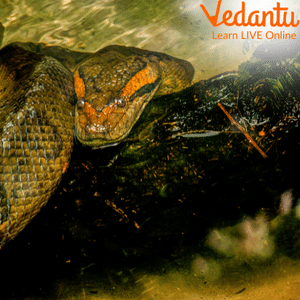




Anaconda: The Deadliest Snake
Anacondas are giant, nonpoisonous snakes. They live near bodies of water and like to hang out in trees. They live in the warm areas of South America. Anaconda will be constrictors. This says that they as a rule kill their prey by coiling their body around it and crushing it until the organism dies. Anaconda is one of the two biggest kinds of snakes on the planet. Anacondas are powerful animals that can grow up to eight meters long and can kill an animal as large as a cow!

Anaconda
Certain pythons develop longer, however, Anaconda is a lot heavier. Anaconda is an individual from the boa family. There are two species, or types, of Anaconda: the large, or green, Anaconda and the yellow, or southern, Anaconda. The giant Anaconda is the bigger species.
Anatomy of Anaconda
It is generally brown or olive green with oval-moulded dark spots. The yellow Anaconda is tan or greenish yellow with covering black spots. The biggest Anaconda arrives at around 30 feet (9 meters) long, however, most commonly reaches around 16 feet (5 meters). A few Anaconda weigh as much as 550 pounds (249 kilograms). Their thick, massive bodies might measure 12 inches (30 centimetres) or more.
Nature of Anaconda
Anaconda generally chases around evening time for mammals, reptiles, and birds. Despite the fact that Anaconda chokes bigger prey, they might kill turtles, birds, or other little creatures by utilizing their mouth and sharp teeth alone. At times they might pull their prey underwater to kill it.
After killing their prey, Anaconda swallows down their prey. Nine months after mating, the female Anaconda brings forth huge litters of live young. A litter has 14 to 82 young. Every young measure was multiple feet (0.6 meters) long.

Anaconda Targeting its Prey
Some Interesting Facts About Anaconda
Common Name: Green Anaconda
Type: Reptiles
Diet: Carnivore
Group Name: Bed, tie
Normal life span: 10 years
Size: 20 to 30 feet
Weight: Up to 550 pounds
Anaconda is normally dark green in colour and has two lines of black spots on their back and white markings on their sides.
Anaconda is normally an extremely huge snake - the green Anaconda is commonly one of the longest snakes on the earth. They have a typical length of 20 feet, yet can ultimately vary up to 30. The nature of the skin of Anakonda is highly elastic. This is the reason they can eat bigger animals also.
Summary
The Anaconda is the biggest snake on the earth. when both weight and length are checked. It can arrive at a length of 30 feet (9 meters) and weigh as much as 550 pounds (227 kilograms). To picture how big that is, assuming around five ten-year-olds sleeping top to bottom, they would be about the length of this giant snake.
The green Anaconda is an individual from a group of snakes called constrictors. Constrictors are not poisonous snakes. They don't kill prey by passing their poison through a bite. All things considered, constrictors fold their bodies over their prey and crush it until it dies.
FAQs on Anaconda Parts
1. Where are anacondas usually found?
Anacondas are usually found in the tropical rainforests of Central and South America, as well as some island nations in the Indian Ocean. In general, an anaconda can be found in a variety of places, which depend on the size and age of the snake. They often live in enclosed spaces like trees or caves.
2. Which animals does the anaconda eat?
When it comes to prey, they are mainly seen eating birds and rodents but sometimes also fish. Anacondas mainly eat birds and rodents such as guineafowls, hutias, pigs and capybara but occasionally they will also eat other reptiles such as caimans and iguanas. In contrast to popular belief, the anaconda is not an apex predator in the area where its found. Another fact is that they will often eat caiman, but they are not at the top of the food chain like some people claim. Due to the anaconda's cardiomorphosis and the snake's constriction method, it can kill its prey within seconds after making a powerful and crushing first strike.
3. What is the scientific name for Anaconda?
The scientific name for Anaconda is Eunectus Murinus, it is also known as water boa or green anaconda.
4. How fast can anacondas swim?
Anacondas are not able to swim fast; they are slow swimmers and prefer to stay in shallow water. They can swim at a maximum speed of around 1.6 miles per hour, which is 6 to 8 kilometres per hour.









